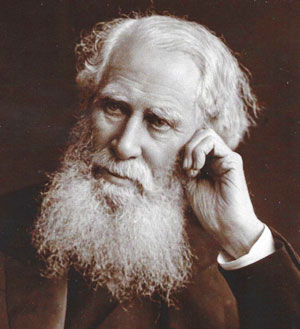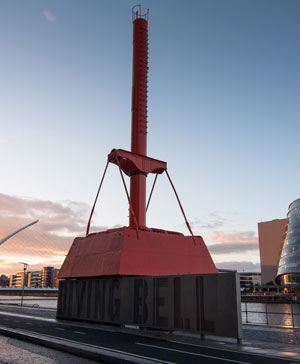By Brian Smyth


On 22 September 2023 a plaque was unveiled at Dublin Port to Bindon Blood Stoney, chief engineer at Dublin Port from 1859 to 1898. He was an innovator throughout his career, willing to experiment with new materials and new engineering techniques.
Stoney was born at Oakley Park, near Parsonstown (Birr), Co. Offaly, and was educated privately before studying engineering at Trinity College, Dublin, under Prof. John Macneill, graduating with a BAI in 1849. On completing his studies, he worked between 1850 and 1852 as an assistant to the 3rd earl of Rosse in Birr Castle, where astronomical observations, using the great 72-inch reflector, had recently commenced. Using this telescope, Stoney confirmed the spiral nature of the great nebula in Andromeda and accurately drew the central part of the Orion nebula (this was before photography was used in astronomy). Stoney kept in contact with the Parsons family during his career and advised the 4th earl on telescope construction.
He went to Spain for his first engineering position, as a surveyor for the Aranjuez to Almansa railway south of Madrid. This was a single-line railway with space to become a double line in the future. Returning to Ireland, he was resident engineer on the construction between 1851 and 1855, under James Barton, of the Boyne viaduct in Drogheda. This was considered an engineering triumph, as it was the largest span in the world at the time. It is 1,760ft in length and has three river spans and fifteen semicircular masonry arch spans. The multiple lattice construction in wrought iron was first used in Drogheda. This was innovative, and various designs and components were tested before use. Stoney’s The theory of strains in girders and similar structures was published in 1866–9 in two volumes.
In 1856 he was appointed assistant to George Halpin in Dublin Port, and in 1859 he took over all the engineering concerns. He was responsible for designing and building deep-water quays and for rebuilding and extending the docks. One of his first duties was to complete work on the graving dock, which had been started by William Dargan, the renowned railway engineer. For the rebuilding of the north and south quay walls he designed a diving-bell (now a museum on Sir John Rogerson’s Quay), which was used to excavate and level the foundations for large precast concrete blocks. Used between 1866 and 1958, the diving-bell could accommodate up to six men and air was supplied by an air-pump on an adjacent barge. It was not a pleasant place to work, and shifts lasted just 30 minutes.
The use of precast concrete blocks was another novel approach. These weighed up to 350 tons and were prepared on site. They took four weeks to make and had to be left for a further ten weeks to cure before they could be used. When the foundation was completed, the blocks were lowered into position using a floating crane. They fitted closely together and by degrees the quay wall took shape. Between 1870 and 1884 the north quays were completed and then work on the south quays commenced. The depth of the quay walls meant that the port was independent of the tides, enabling larger ships to dock.
In 1867 the Dublin Port and Docks Board assumed responsibility for all the bridges up to Kingsbridge (now Heuston) Station. As port engineer, Stoney oversaw the rebuilding of Essex (now Grattan) Bridge, linking Capel Street to Parliament Street, which opened in 1874. Carlisle (now O’Connell) Bridge was widened and reconstructed between 1877 and 1880 and opened in 1882. In 1878 the Beresford Swing Bridge was constructed to allow the passage of ships. This was later dismantled to allow the building of Butt Bridge in 1932.
Stoney married Susannah Francis Walker in 1879 and they had three children. He retired in 1898 and was replaced by John Purser Griffith (1848–1938), who had been his assistant for the previous 27 years. He was president of the Institution of Civil Engineers of Ireland from 1871 and received their Telford Medal and Premium in 1874 for a paper ‘On the Construction of Harbour and Marine Works with Artificial Blocks of Large Size’. He was awarded an LLD from Trinity College, Dublin, in 1881, and was elected a Fellow of the Royal Society the same year.
Bindon Blood Stoney died in 1909 and is buried in Mount Jerome Cemetery in Dublin
Brian Smyth is chair of the National Committee for Commemorative Plaques in Science and Technology.
